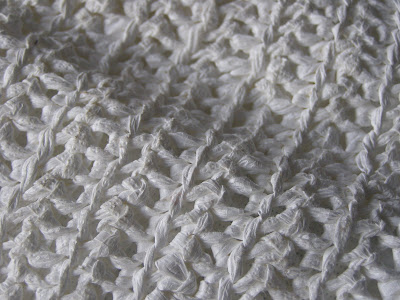


Having worked with Koloron for a few years I see it differently from people who have not experienced the adaptable nature of this unique material.
My pleasure starts when I run my hands over its surface. It feels like a quality watercolour paper and thoughts turn to brushes and flowing paint. Big brushes filled to the point of overload, dripping large blobs of pure bright colour over the brilliant white surface.
What one can't do with watercolour paper is to grab a handful and crunch it up and then flatten it out again. With Koloron you can and you're left with a pattern of lines and creases, a change of texture and the beginnings of 3D working. Do the same thing with an area coloured bright red and the uniqueness of this fabric starts to reveal itself. Unlike paper Koloron will tolerate any amount of folding, creasing, gathering, ruching and wringing. You can even crochet strips of Koloron, weave with it and plait it into ropes. And you can choose to colour it before or after you've started the creative process.
Martin Charles* the Haute Couture designer working near Northampton UK said " I started by using Koloron for pattern making. The Art Fabric is exceptionally strong and unlike paper can be modelled on the stand before cutting the pattern out. Furthermore it doesn't tear or fray, qualities that make it ideal for this purpose. My next step was creating designs. I found the Art Fabric stitched easily and could be gathered, pleated or simply draped. And it could be moulded, wired and bonded to make structured clothes such as a fitted jacket" And that was before he got going with colour.
I find if you use a flexible paint that will not crack when the fabric is flexed you can colour the work when it is nearing completion. Alternatively using a heavy polyurethane spray will ensure the fabric doesn't flex. This way you get the fluid nature of fabric transfixed permanently in the shape you have created. Start to mix colour, varnishes and heat and the character of Koloron changes again.
Martin said "Acrylic, emulsion and spray paint all cover well. The paint doesn't seep through the fabric. Glue and glitter are just as successful. A completely different effect was achieved by ironing a colour photocopy onto the Art Fabric. As the heat of the iron melted the Art Fabric the colours from the photocopy showed through".
A heat gun will open up even more possibilities. Koloron Art Fabric becomes completely transformed and becomes a moulding medium that draws colour into a 3D composition.
Art Fabric can be all things to all artists whether they are greeting card designers, scenery builders or are looking to hang in the Tate Gallery. Koloron has excitement in store for all of them.
John Winter
Head of Art, Koloron Ltd
* Martin Charles owns the 'No Shrinking Violets' label www.noshrinkingviolets.co.uk
What one can't do with watercolour paper is to grab a handful and crunch it up and then flatten it out again. With Koloron you can and you're left with a pattern of lines and creases, a change of texture and the beginnings of 3D working. Do the same thing with an area coloured bright red and the uniqueness of this fabric starts to reveal itself. Unlike paper Koloron will tolerate any amount of folding, creasing, gathering, ruching and wringing. You can even crochet strips of Koloron, weave with it and plait it into ropes. And you can choose to colour it before or after you've started the creative process.
Martin Charles* the Haute Couture designer working near Northampton UK said " I started by using Koloron for pattern making. The Art Fabric is exceptionally strong and unlike paper can be modelled on the stand before cutting the pattern out. Furthermore it doesn't tear or fray, qualities that make it ideal for this purpose. My next step was creating designs. I found the Art Fabric stitched easily and could be gathered, pleated or simply draped. And it could be moulded, wired and bonded to make structured clothes such as a fitted jacket" And that was before he got going with colour.
I find if you use a flexible paint that will not crack when the fabric is flexed you can colour the work when it is nearing completion. Alternatively using a heavy polyurethane spray will ensure the fabric doesn't flex. This way you get the fluid nature of fabric transfixed permanently in the shape you have created. Start to mix colour, varnishes and heat and the character of Koloron changes again.
Martin said "Acrylic, emulsion and spray paint all cover well. The paint doesn't seep through the fabric. Glue and glitter are just as successful. A completely different effect was achieved by ironing a colour photocopy onto the Art Fabric. As the heat of the iron melted the Art Fabric the colours from the photocopy showed through".
A heat gun will open up even more possibilities. Koloron Art Fabric becomes completely transformed and becomes a moulding medium that draws colour into a 3D composition.
Art Fabric can be all things to all artists whether they are greeting card designers, scenery builders or are looking to hang in the Tate Gallery. Koloron has excitement in store for all of them.
John Winter
Head of Art, Koloron Ltd
* Martin Charles owns the 'No Shrinking Violets' label www.noshrinkingviolets.co.uk
















